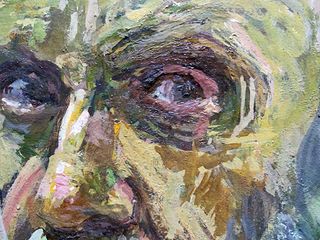
The painter's eye. Detail of Dr. Atl (Gerardo Murillo) 1962 self-portrait, oil on cardboard. Private collection.
Gerardo Murillo was born in 1895 in the San Juan de Dios neighborhood of Guadalajara, at the height of the Francophile rule of Mexican president/dictator Porfirio Díaz. He began studying painting at the age of 19. Since studying in Italy in 1921, Gerardo Murillo has been better known as 'Dr. Atl' (atl is the Náhuatl word for water), as he was re-christened by Leopoldo Lugones, an Argentine writer and leftist political colleague. After his death in 1964, his ashes were interred in Guadalajara in what is known today as the Rotonda de Jaliscienses Ilustres (the Rotunda of Illustrious People of Jalisco). During his life, Dr. Atl was profoundly eccentric, his entire being immersed in his passions for painting, for politics, and particularly for volcanos.
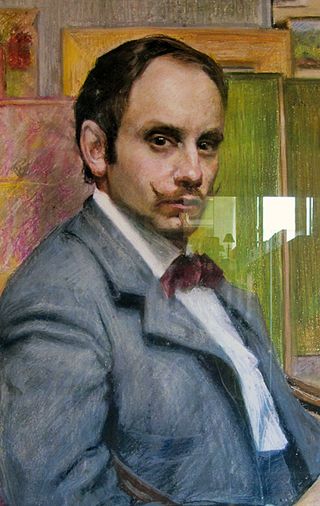
Gerardo Murillo, self portrait 1899. All photos by Mexico Cooks! unless otherwise noted.
The Museo Colección Blaisten, part of Mexico City's Centro Cultural Universitario Tlatelolco (part of the UNAM, the huge multi-campus National Autonomous University of Mexico), mounted a December 2011 through April 2012 exhibition if 190 of Dr. Atl's masterworks. Dr. Atl, one of Mexico's most prominent 20th century painters, is actually very little known in the United States.
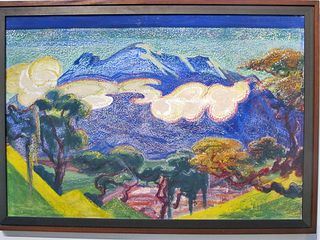
Volcán Iztaccíhuatl (the Sleeping Woman volcano), 1916. Colleción Museo Regional de Guadalajara-INAH. Labels of this and many other paintings in the exhibit indicate that they were painted using Atl color (a type of paint created by the artist). Atl color is similar to Greek encaustic paint. It contains resins, wax, and dry pigment which are melted, mixed, and hardened to form a medium similar to oil pastel. Dr. Atl used his eponymous colors on paper, cardboard, rough fabric such as jute, wood, and other bases.
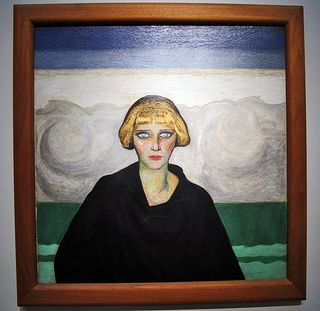
Although Dr. Atl is best-known as the passionate painter of volcanos, he also painted portraits. Nahui Olín, pictured above in 1922, had a five-year romantic relationship with Dr. Atl. During the early part of her life, Nahui Olín's name was Carmen Mondragón. Dr. Atl gave her the Náhuatl name to honor the date in the Aztec calendar that commemorates the renovation of the cosmic cycles. Private collection.
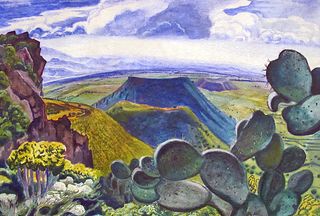
The Valley of Mexico from the South, 1931, oil on fabric. Private collection.
Dr. Atl's scholarly observation and study of Mexican geography (he was not only a painter, but also a volcanologist and writer) combined perfectly with his travels in Europe to give him the tools necessary to become one of the outstanding landscape painters of the 20th century. In 1897, then-Presidente Porfirio Díaz gave young Gerardo Murillo a scholarship to study in Europe. Murillo studied not only Italian frescoes but also philosophy and penal law. He involved himself ever more deeply with leftist, anarchist politics, a consequence of his studies that President Díaz probably did not anticipate.

Dr. Atl was also an exceptional painter of clouds. This painting is Nubes sobre el Valle de México (Clouds over the Valley of Mexico), 1933, Atl color on asbestos. Collection Museo Nacional de Arte INBA.
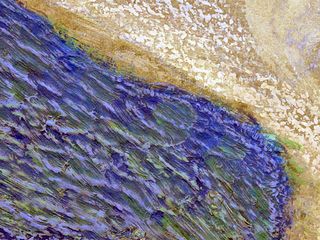
Detail mid-right side, Nubes sobre el Valle de México. Note the variety of brushstroke used to create texture in the painting. Click on any photograph to enlarge the detail.
Dr. Atl began studying volcanoes during a trip to Italy in 1911. Beginning in 1925, he spent long periods of time at Mexican volcanoes such as Popocatépetl, Iztaccíhuatl, and the Pico de Orizaba. A tireless traveler, Dr. Atl climbed Popocatépetl and Iztaccíhuatl. Later those volcanoes became an important theme in his body of work.
In 1942, he visited the site of Mexico's newborn volcano Paricutín in the state of Michoacán. He said, “…El espectáculo del cono ardiente vertiendo aludes de materia ígnea, bajo un cielo de guijarros incandescentes, en sí mismo tan fuera de lo común que toda invención sale sobrando…” 'The spectacle of the burning cone spewing avalanches of lava under a sky of incandescent ash was by itself so far out of the ordinary that every other invention became like something left over…'
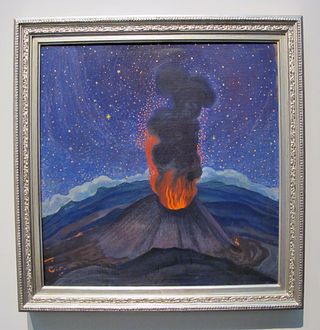
Volcán en la Noche Estrellada (Volcano on a Starry Night), 1950 (Paricutín). Atl color on plywood. Collection UNAM. Dr. Atl was the first artist to paint what he called 'aeropaisajes' (landscapes from the air); he took to the skies in small airplanes, flying over various volcano sites to immortalize them from above.
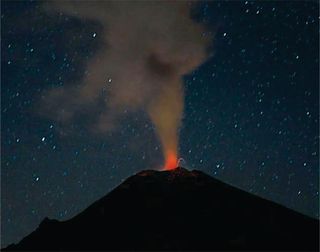
Life imitates art. April 16, 2012 photo of volcano Popocatépetl spewing flame, ash, and smoke. Popocatépetl straddles the state line between Puebla and Morelos, approximately 40 miles south of Mexico City. Photo courtesy Todo Oaxaca.
Dr. Atl, astonished and awed to see a volcano born in his lifetime, lived for approximately a year near still-erupting Paricutín. He observed, painted, and wrote about this majestic and completely unexpected young volcano for more than seven years.

Cráter y La Vía Láctea (Crater and the Milky Way), 1960. Oil and Atl color on masonite. Private collection, courtesy of Galería Arvil.
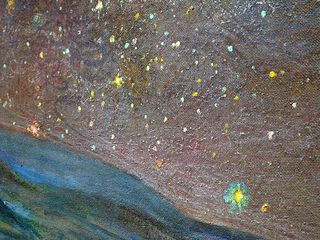
Detail, Cráter y La Vía Láctea.
For his entire life, Dr. Atl involved himself in left-wing political movements. In 1914, he allegedly was part of the plot to assassinate then-President Victoriano Huerta, because of which he was imprisoned briefly. After his release, he lived in Los Angeles, California until 1920. When he returned to Mexico, revolutionary leader and President Venustiano Carranza named him director of the Escuela de Bellas Artes (School of Fine Arts) and then Jefe de Propaganda e Información en Europa y América del Sur (Head of Promotion and Information in Europe and South America), a position he held for only a short time.
In 1956 Mexico awarded him the Medalla Belisario Domínguez and, in 1958, the Premio Nacional de las Artes.
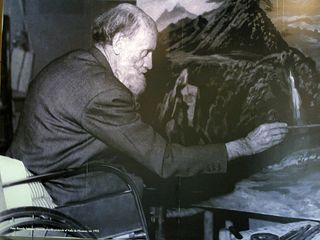
Gerardo Murillo Pintando en el Valle de Pihuamo (Gerardo Murillo painting in the Valley of Pihuamo), 1952. Photo by Ricardo Salazar. Dr. Atl's right leg was amputated in 1949. Popular legend has it that the amputation was due to the inhalation of gases at Paricutín, but it was actually necessary because of complications of diabetes.
Mexico gave poet Carlos Pellicer the task of writing Dr. Atl's biography. Dr. Atl wrote to him, "Now it looks like a biography will really get off the ground! A couple, nearly human, came from Los Angeles as if they had fallen from heaven, to write a biography of me. Then I remembered that you were writing one. To make a long story short, I make the following proposal: you finish the biography that you already started. I enclose a slip of paper with some suggestions for organizing it in the most convenient way…I send you the most cordial handshake…" Some of the biographical material was printed in Carlos Pellicer en el Espacio de la Plástica, Volume 1, by Elisa Garcìa Barragán and Carlos Pellicer, UNAM 1997.
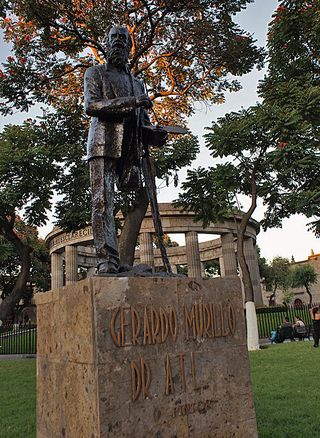
Dr. Atl died in Mexico City on August 15, 1964. His ashes are buried in the Rotonda de Jalisciences Ilustres in Guadalajara, where this statue is part of the site. Photo courtesy Rodrigo_gh, Flickr.
The five-month exhibition was an opportunity to see, through the eyes of this genius painter, the Valley of Mexico before Mexico City's explosion of population with its lava-like rivers of concrete swallowed nature whole. We had the chance to see the Valley and its volcanos when they ran with rivers, when the mountains burgeoned with trees and flowers.
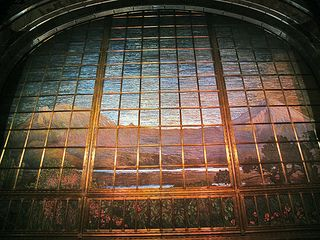
Today, even though the exhibition has closed, we can see Dr. Atl's vision of the Valley of Mexico every time we visit the Palacio de Bellas Artes in Mexico City's Historic Center. His design, executed by the house of Louis Comfort Tiffany, is immortalized in the theater's million-piece stained glass curtain.
Looking for a tailored-to-your-interests specialized tour in Mexico? Click here: Tours.
Leave a Reply to Rossana F Cancel reply